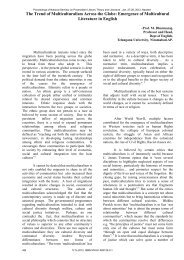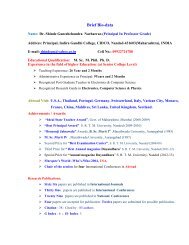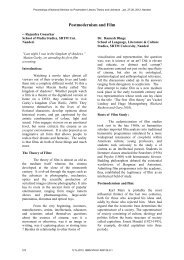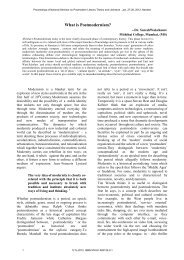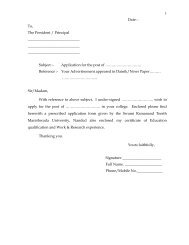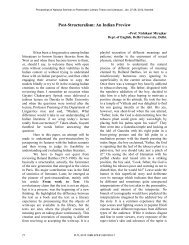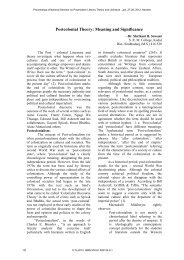Postcolonial Feminist Theory: An Overview - Igcollege.org
Postcolonial Feminist Theory: An Overview - Igcollege.org
Postcolonial Feminist Theory: An Overview - Igcollege.org
You also want an ePaper? Increase the reach of your titles
YUMPU automatically turns print PDFs into web optimized ePapers that Google loves.
Proceedings of National Seminar on Postmodern Literary <strong>Theory</strong> and Literature , Jan. 27-28, 2012, NandedThe Dalit feminist standpoint is about historicallylocating how all our identities are not equallypowerful, and about reviewing how in differenthistorical practices similarities between womenhave been ignored in an effort to underline casteclassidentities, or at other times differencesignored for ‘the feminist cause’ (Sangati: Introduction, p.xvii)Woman has been the victim of social injusticeand exploitation since the time immemorial. In Indiawomen is called Mata, Devi and Laxmi and apparentlyshe seems to be given due respect in society, but reallyshe was been reduced to an inferior status. In this land ofmale-chauvinist where social life is controlled by menand the customary laws are framed by men to suit hisselfish end, woman if often subjected to endless tortureby the pleasure seeking selfish husband. The conventionalsociety provides man many rights and freedoms but itdebars woman from them. Indian woman has the status ofa slave. Her duties are to work, to clean, to please herhusband’s libidinous desires and to submit herself to hermale chauvinism and physical violence. Burning womanto death and offering her for humiliation and prostitutionby the faithful and powerful husband has been thepractice of this spiritual land. Rama allowed Sita to beconsigned to fire and exiled her merely on the basis of thederogatory words used by a whimsical, ignorant andwicked dhobi. There seems no element of rationality inthe decision of Lord Rama. What to speak of an ordinaryman of this so-called spiritual land where the attitude ofthe Lord Himself to woman is like this. Similarly, inMahabharta, Draupati is put to dice by the so-calledDharmaraja. She is also humiliated in the presence of thegreat warriors, learned men and even her five mightyhusbands for whom she has been bearing the label ofpolyandry.Laxmi Holmstorm points out in the Introductionof her translated book that, women are presented inSangati by Bama as wage earners as much as men are,working as agricultural and building site laborers, butearning less than men do. Yet the money that men earn istheir own to spend as they please, whereas women bearthe financial burden of running the family, often singly.There are also constantly vulnerable to sexual harassmentand abuse in the world of work. Within the community,the power rests with men: caste-courts and churches aremale-led, and rules for sexual behavior are very differentfor men and women. Hard labor and economicprecariousness leads to a culture of violence and this is atheme that Bama explores boldly throughout the book.Dalit women can not bear the torment of uppercastemasters in the fields and at home they can’t bear theviolence of their husbands. In this connection Bamawrites:Even though they are male, because they areDalits, they have to be like dogs with their talesrolled up when they are in the fields, and dealingwith their strength in those circumstances. Sothey show it at home on their wives and children.Is it the fate of our Dalit women to be tormentedboth outside their houses and within ?( Sangati, p.65)The telling description of Dalit women at thebottom of social pyramids, as seen by Dr. B.R Ambedkaris crucial in understanding their position as the lowest oflow. Dr. Ambedkar saw the Hindu caste system as apyramid of earthen pots which are put on one another. Inthis structure not only the privileged castes of Brahminsand Ksatriyas are at the top and Shudras and untouchablesat the bottom but within each earthen pot ‘men are at thetop and women of that caste are on the bottom likecrushed and wasted powder. <strong>An</strong>d at the very bottom arethe Dalits and below them are the suppressed Dalitwomen’. ( Karan Sing Yadav:2009,p.103)Bama shows that how the Dalit women becomethe subject matter of misbehavior without their any fault.One of the characters Mariamma began to feel totally fedup with life. She says:For no fault of mine, I get abused wherever I go.Did I ever look that fellow in the face even? yetthe people of this village call me every kind ofname. Sangati, p.40)No doubt Bama’s grandmother becomes therepresentative of women’s movement. In the false case ofsexual misbehavior of Mariamma. Bama’s grandmothercomments:“when the fellow pulled you into the shed, whycouldn’t you have kicked him in the balls themand there?” ( Sangati, p. 28)Bama explained, how the upper-caste womendon’t show their pity or kindness to the Dalit-women ifonly as women to women, but they treat them withcontempt. They themselves lead lives shut up inside theirhouses, eating, gossiping and doing their husbands’bidding and them they treat Dalit women badly. Godknows how they stay shut up within four walls, alltwenty-four hours of the day. From this feministperspective, Bama explains:It seems that at least our women work hard andearn their own money, and have a few coins intheir hands. They don’t hold out their palms totheir husbands for every little expense, like thoseothers. All the same, because of our caste andbecause of our poverty, every fellow treats uswith contempt. If ever there is a problem or adisturbance, everyone starting with the police,chooses to blame and humiliate the women of ourcommunity. The government does not seemprepared to do anything to redress this. So wemust take up the challenge ourselves ( Sangati,p.66)313 PLTL-2012: ISBN 978-81-920120-0-1



